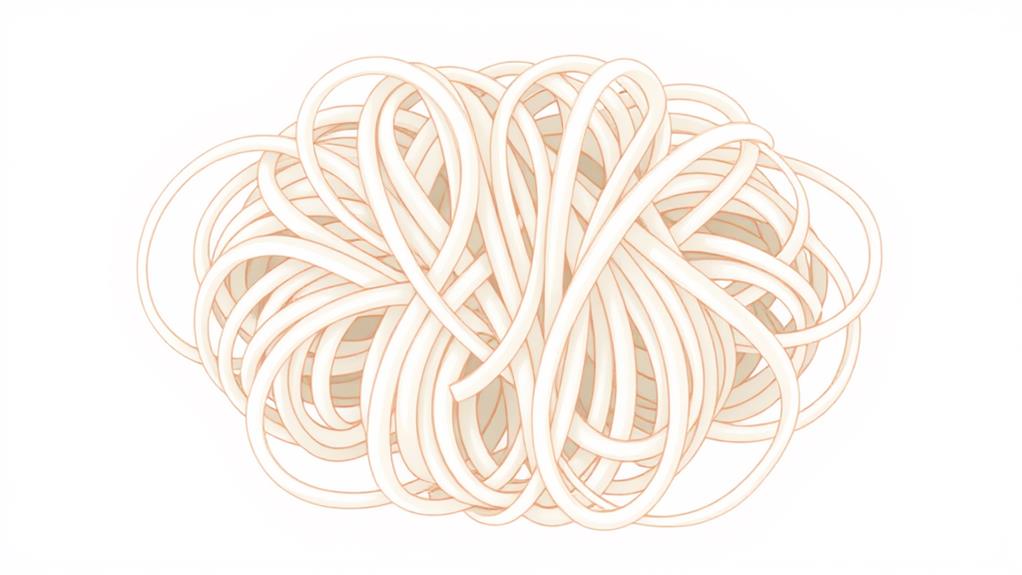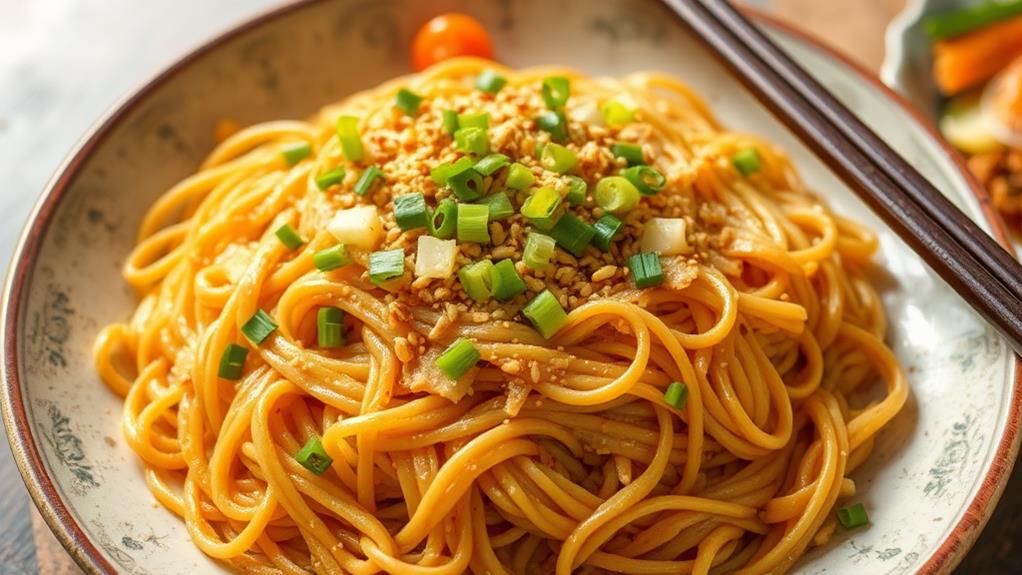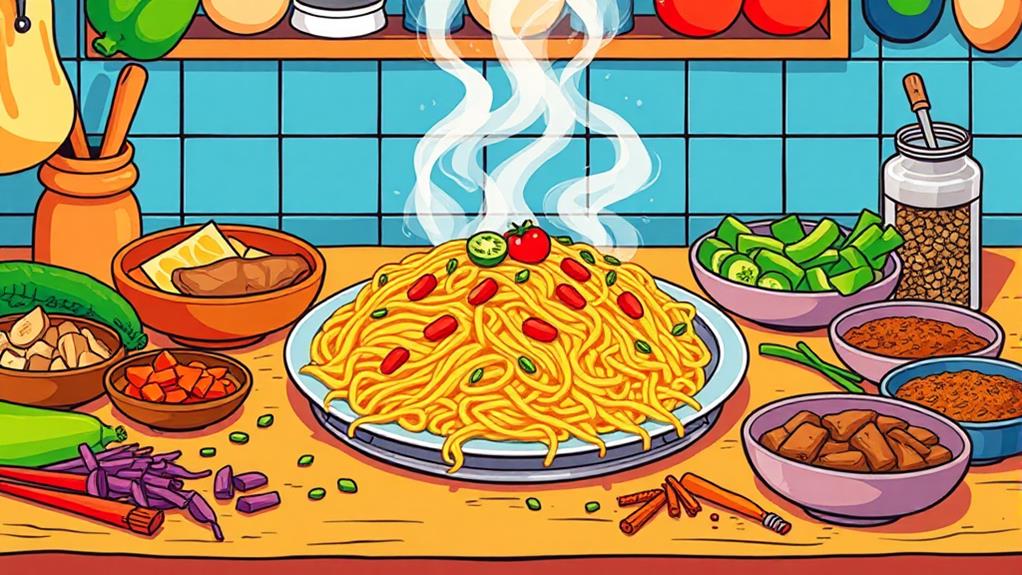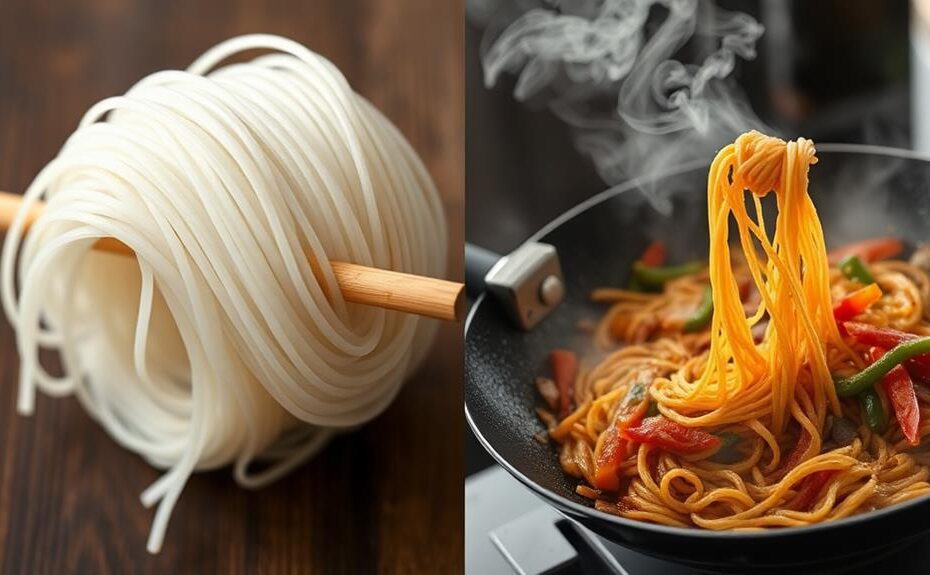Pancit rice noodles are a staple in Filipino cuisine, primarily made from rice flour.
There are various types of pancit, including bihon, canton, and Malabon, each offering distinct textures and cooking characteristics.
Rice grains are soaked, ground, and steamed to create chewy noodles.
Bihon is the most popular type of pancit, and it is gluten-free, making it ideal for absorbing flavors.
To prepare bihon, the noodles are soaked in warm water, not boiled, and then stir-fried with proteins and vegetables to enhance flavor absorption.
Understanding Pancit Noodles

Pancit noodles are a staple in Filipino cuisine, commonly made from rice flour. The most popular type is bihon, thin, translucent rice vermicelli that don't require boiling but only soaking in water to soften.
Other types of pancit noodles include canton (thick egg noodles) and Malabon (thick rice noodles), each offering different textures and flavors.
Traditional pancit noodles are often stir-fried with a combination of proteins and vegetables, absorbing flavors from savory sauces and chicken broth.
To achieve the perfect texture and flavor, it's essential to follow specific cooking tips, such as soaking the noodles correctly and controlling the heat while stir-frying.
Mastering pancit requires understanding the different types of noodles, as each type absorbs flavors and cooks differently.
Ingredients and Preparation
Pancit Rice Noodles: Ingredients and Preparation
To prepare pancit rice noodles, two main ingredients are required: rice flour and water. The production process involves soaking, grinding, and steaming rice grains to create thin, chewy noodles.
The resulting bihon noodles are gluten-free, making them perfect for absorbing flavors from sauces and broths during cooking.
Preparing bihon noodles doesn't require boiling. Instead, soak them in warm water for 8-10 minutes until they're softened. This makes them ready for cooking in your favorite pancit dish.
As you cook the noodles, they'll absorb the rich flavors of the sauces and broths, leading to a savory final dish.
With bihon noodles, you can experiment with various flavors and seasonings to create unique pancit recipes. By understanding the ingredients and preparation process, you'll be able to create delicious and authentic pancit rice noodle dishes.
Cooking and Serving Methods

Cooking Pancit Rice Noodles
To bring out the best flavors, stir-fry the noodles with sautéed garlic, onions, and vegetables in a wok. This cooking method allows the bihon noodles to absorb the flavors of the ingredients beautifully.
You can add proteins like chicken or shrimp to make the dish more substantial.
Using a Wok
Use a wok to ensure even heat distribution, which preserves the texture and color of the noodles and vegetables. This is essential for achieving the perfect texture and color.
Serving Pancit
Serve your pancit hot, garnished with a squeeze of calamansi or lime juice for added flavor.
You can also serve it with side dishes like lumpia for a complete meal.
Cultural Significance and Variations
Pancit's Cultural Significance
Pancit is more than just a flavorful meal; it's a symbol of long life and prosperity in Filipino culture. It's often served at birthdays, holidays, and family gatherings, emphasizing its role in bringing people together during celebrations and special occasions.
Variations of Pancit
Pancit's regional variations, such as Pancit Bihon, Pancit Canton, and Pancit Malabon, showcase local ingredients and flavors. Each region in the Philippines has its own unique take on pancit, incorporating local ingredients and flavors.
For example, Pancit Bihon is made with rice flour noodles, while Pancit Canton uses wheat flour noodles. These variations contribute to the rich diversity of Filipino culinary heritage.
Historical Roots
The term "pancit" itself reflects its historical roots in Chinese cuisine, derived from the Hokkien word for "conveniently-cooked food." This historical connection highlights pancit's adaptability, which has evolved over time to become an integral part of Filipino celebrations and traditions.
Can Pancit Rice Noodles be used in Filipino-style spaghetti with banana ketchup?
Yes, pancit rice noodles can be used in Filipino-style spaghetti with banana ketchup. This unique twist on spaghetti is a popular dish known as banana ketchup spaghetti in the philippines. It combines the traditional Italian flavors with Filipino ingredients, resulting in a sweet and savory pasta dish loved by many.
Tips and Recipe Customization

Customizing Pancit for Nutrition and Flavor
Fresh vegetables like bell peppers, bean sprouts, and broccoli enhance the nutritional value and flavor of pancit. By incorporating your favorite vegetables, you can create a nutritious and filling meal.
Vegetarian and Seasoning Options
To customize your pancit recipe, consider the following:
- For a vegetarian option, substitute meats with tofu or additional vegetables and use vegetable broth instead of chicken or pork broth.
- Experiment with seasoning levels by trying different soy sauces, adding fish sauce for depth, or incorporating citrus juices for brightness.
Dietary Restrictions and Gluten-Free Options
To cater to dietary restrictions:
* Use gluten-free noodles made from rice flour, ensuring the dish remains accessible to those with gluten sensitivities.
Frequently Asked Questions
What Are Pancit Noodles Made Of?
Pancit noodles are primarily made from rice flour and water, giving them a thin, chewy texture. This is the case for bihon, a common type of pancit noodle. The type of flour used affects the gluten content, with bihon being gluten-free.
However, pancit canton is an exception, made with wheat flour and eggs for a thicker bite. This difference in ingredients results in varying gluten contents, with canton not being gluten-free.
Understanding the ingredients is essential for exploring different cooking techniques and flavor profiles to enjoy these noodles in various regional dishes and popular recipes.
Are Pancit Noodles Healthy?
Pancit noodles can be a healthy choice, but it depends on the ingredients and cooking methods used.
Pancit noodles themselves are gluten-free and provide quick energy due to their high carbohydrate content.
However, they lack essential nutrients like protein and fat.
To make pancit noodles a healthier option, incorporate vegetables like bean sprouts, cabbage, and carrots to add fiber, vitamins, and minerals.
Add lean proteins such as chicken, shrimp, or tofu to provide essential amino acids.
Use portion control to avoid consuming excessive calories.
Be mindful of sauces and seasonings, as they can add high amounts of sodium.
Opt for regional variations with lighter flavor profiles, such as using fish sauce or lime juice instead of soy sauce.
Consider dietary restrictions when serving, such as using gluten-free soy sauce for those with gluten intolerance.
Are Rice Noodles Healthier Than Regular Noodles?
Rice noodles are a healthier alternative to regular noodles. As a gluten-free option, they cater to individuals with dietary restrictions, such as those with celiac disease or gluten intolerance.
Rice noodles have fewer calories, making them an excellent choice for weight management. For instance, a 1-cup serving of cooked rice noodles contains approximately 110-120 calories, whereas regular noodles can have up to 200 calories per serving.
Although rice noodles are often low in fiber, opting for brown rice-based noodles can increase the fiber content. Their versatility in various dishes and cooking methods also makes them a great addition to meal options.
What Does Pancit Taste Like?
Pancit's flavor profile is a harmonious blend of savory and sweet notes. The delicate noodles absorb flavors well, allowing the seasonings and ingredients to stand out.
Regional variations may exist, but a common elevating factor is the addition of citrusy calamansi juice or lemon. This subtle flavor makes pancit a versatile dish that pairs well with a variety of ingredients.
